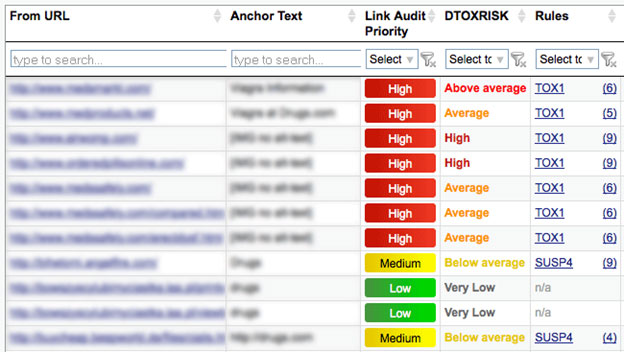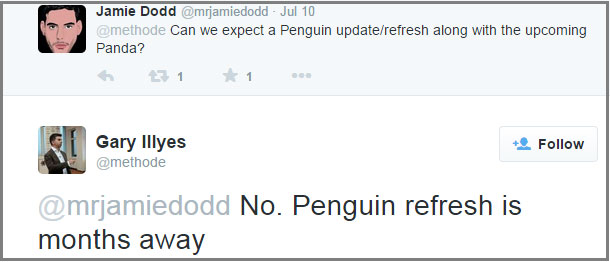
Since I was a kid I have been watching nature shows but penguins are now definitely on my no-fly list. I’d rather have to debate Donald Trump about real estate deals in front of 24 million people than have a truly awful Google Penguin (link penalty) come after me and my site.
For those of you who are unaware of what the Google Penguin update is all about, here is a nice blurb from Search Engine Land:
“What Is The Google Penguin Update?
Google launched the Penguin Update in April 2012 to better catch sites deemed to be spamming its search results, in particular those doing so by buying links or obtaining them through link networks designed primarily to boost Google rankings. When a new Penguin Update is released, sites that have taken action to remove bad links (such as through the Google disavow links tool or to remove spam may regain rankings. New sites not previously caught might get trapped by Penguin. “False positives,” sites that were caught by mistake, may escape.”
- Diagnose the situation and take responsibility
Saying “I had no idea!” Is the wrong answer.
Whether or not you intentionally got bad links pointed at your website, the consequences are the same. Google will never give you any significant traffic until you correct the problem. It may be that your previous SEO company did low quality article and directory link building, scraper sites have scooped up your content including your links and put them in bad places or it may even be that people are pointing negative links at you intentionally.
Don’t make the mistake of waiting to sort this out because it’s important that you do the repair work before the next Google Penguin refresh. More on that in a minute.
There are two main types of situations with Google Penguin penalties.
- Google sends you a manual penalty notification through the Google Search Console (formerly Google Webmaster Tools).
- Google doesn’t tell you anything and uses its advanced algorithms to filter you out of the search results because they think you have a lot of bad links.
I am not going to go into great detail about how to do Penguin repair in this short post but will certainly cover it in more detail soon. Below are some of the basics to consider.
 SEMrush is a great tool that allows you to quickly see how many keywords are driving traffic to your website. The picture below shows a site with few keywords driving traffic and almost no search value. While the traffic amounts are often wrong with these types of tools, a traffic value of 1 shows it’s unlikely there are many unique visitors either.
SEMrush is a great tool that allows you to quickly see how many keywords are driving traffic to your website. The picture below shows a site with few keywords driving traffic and almost no search value. While the traffic amounts are often wrong with these types of tools, a traffic value of 1 shows it’s unlikely there are many unique visitors either.
This can be VERY frustrating when you used to have traffic and see something like this happen.
You will also want to look at Google Analytics to review your organic search traffic (even a glance at overall traffic can sometimes show obvious issues). Look for dips in traffic aligned with Google Penguin release dates.
The following chart may not be as dramatic as many as you have seen but is excellent to review for smaller sites with confusing penalties.

If you see drops in traffic aligned with Penguin Release dates, you have likely been hit.
Google Penguin release dates
- Penguin 1.0 on April 24, 2012 (impacting ~3.1% of queries)
- Penguin 1.1 on May 26, 2012 (impacting less than 0.1%)
- Penguin 1.2 on October 5, 2012 (impacting ~0.3% of queries)
- Penguin 2.0 on May 22, 2013 (impacting 2.3% of queries)
- Penguin 2.1 on Oct. 4, 2013 (impacting around 1% of queries)
- Penguin 3.0 on October 17, 2014 (impacting around 1% of queries)
- Use a tool like Link Detox and your brain to decide what links are good and which should be disavowed
Tools like Link Detox, can give you a quick breakdown of the worst quality and best quality links in your profile.

Don’t rely solely on tools
None of these tools are even close to perfect, so unfortunately you are going to have to look at every one of the links that point at you by clicking on them to see if they look legitimate.
You can also use SEMrush to see if they have any keywords driving traffic and what the traffic value to their site is. If they only have a handful of keywords driving traffic and little to no traffic value, then you may not want them linking to you until they correct their own problems.
This chart shows keyword traffic history:

- Submit your list of bad links to Google using the disavow tool
Now it’s time to submit your spreadsheet to Google, using the disavow tool to let them know which links you admit are bad.

Check out some of my team members at McDougall Interactive discussing “What is the Google Disavow tool?”.
- Manual penalty removal
If you have a manual penalty notification in the Google Search Console, write a letter to Google explaining how the bad links happened, how you have rectified it and asked them to remove the penalty.
- Get more good quality links to your site before the next Penguin refresh
The next step is to make sure that you get good quality links to your site to balance out the ratio of good to bad links. Removing the bad links will only make it so Google will not use those against you. This might help your ranks come back to some degree but it’s only by getting new good links and by writing regular good content that you will improve your authority and rankings.
- Don’t put all your eggs in one basket while you’re waiting
If your website has had a significantly bad link problem, which may include a manual penalty and possibly algorithmic filtering at the same time, it may take literally years to recover.
We have seen some people recover very quickly. Like right after doing a disavow and when we are doing good content, link outreach and SEO at the same time.
We have also seen some people take years to recover and it may be that Google decides to simply spank you with a penalty like a father grounds his child. It is entirely possible that they set a date for you to recover – a couple years out – depending on how bad they think you broke their guidelines.
Sometimes it feels like there is no rhyme or reason to getting a site out of its authority injury, no matter how much content or good links to add.
This shows a site that did a lot of things right – disavow, manual penalty removal, new super high quality links and awesome content – yet having no results:

The truth is that you may have to wait through a couple of Penguin refresh cycles, which historically have been either six months or one year apart. Ouch.
Marie Haynes, writing for Search Engine Watch says: “You won’t see the benefits of your hard work until a Penguin refresh happens.”
- Watch the news for refresh dates like a hawk
Sadly, you may have to wait a few more months for Google to rerun its algorithms for the changes you have been making to take full effect. Check out some of the latest news on when the next refresh will be and keep a close watch on when updates will be released:
Next Google Penguin Update? Jim and Ann Show
Google Says Penguin Refresh Months Away From Happening

In conclusion
If you have a lead weight dragging you down, you won’t succeed no matter what you do. Having an authoritative site that has lots of keywords driving traffic and leads is essential for any company and or thought leader.
Therefore you must make sure to try your best to fix Google penalty issues as fast as possible while potentially also blogging on other domains while you are waiting for your main site to be fixed.
Believe it or not even Google sometimes recommends getting a new domain name when you have a very bad penalty. How bad does that stink for your brand to have to change its online name?
